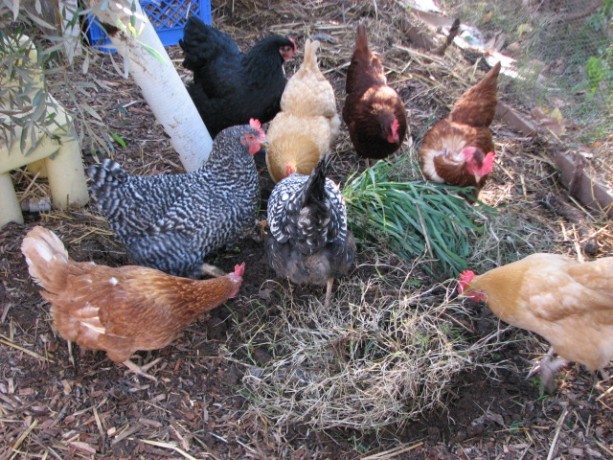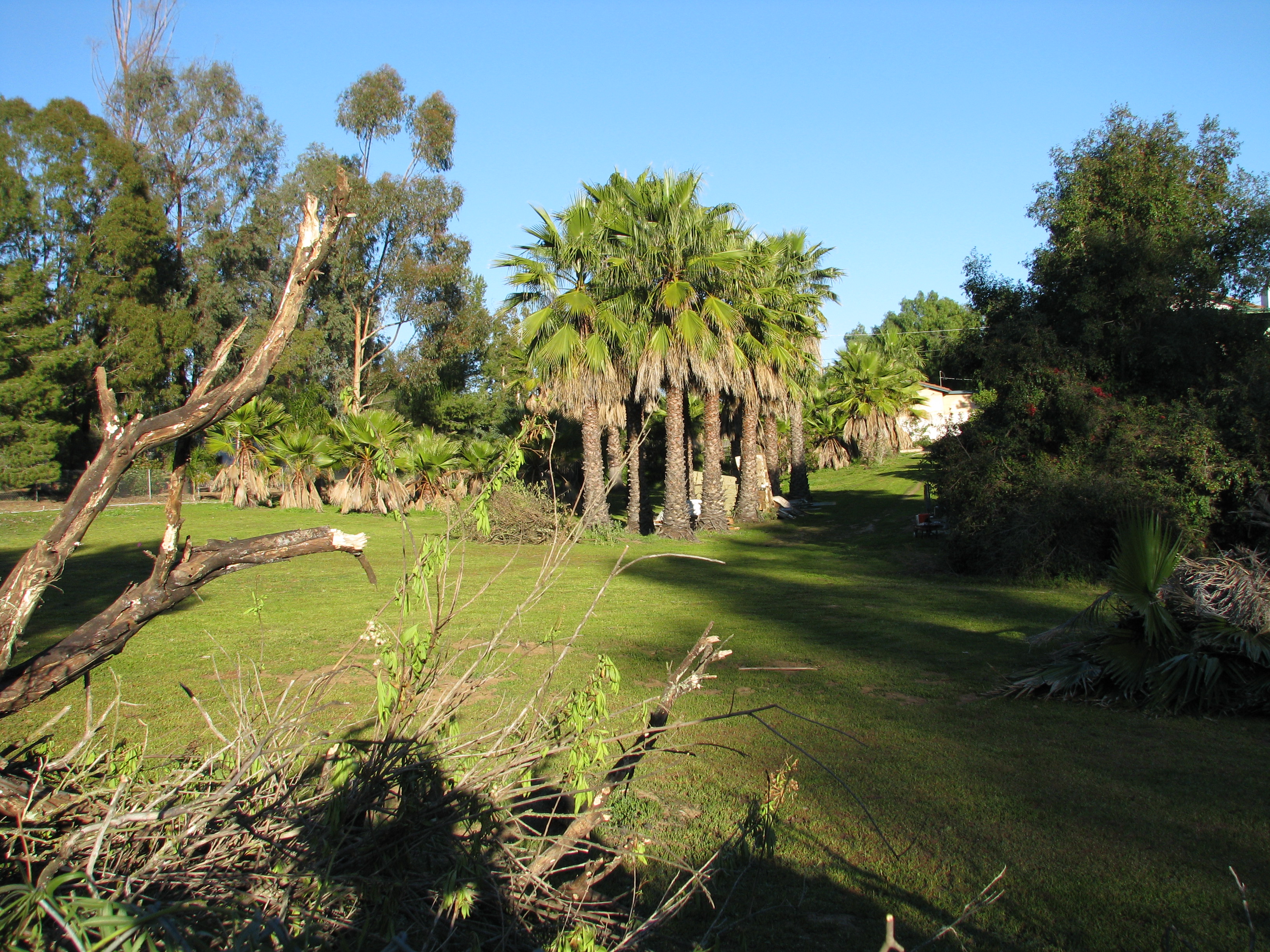- Animals, Bees, Birding, Building and Landscaping, Chickens, Compost, Composting toilet, Culture, Gardening adventures, Giving, Health, Heirloom Plants, Houses, Hugelkultur, Humor, Irrigation and Watering, Living structures, Microbes and Fungi, Natives, Natural cleaners, Other Insects, Perennial vegetables, Permaculture and Edible Forest Gardening Adventures, Pets, Planting, Ponds, Predators, Rain Catching, Recycling and Repurposing, Reptiles and Amphibians, Seeds, Soil, Vegan, Vegetables, Vegetarian, Water, Water Saving
Projects for the New Year
 Take on one project this year that will help improve the earth. Just one. If you can manage more, fantastic. However make sure that you are fully mindful of all aspects of your project so that is it done as well as it can be.
Take on one project this year that will help improve the earth. Just one. If you can manage more, fantastic. However make sure that you are fully mindful of all aspects of your project so that is it done as well as it can be.For instance, decide to use greywater. If you can physically and legally connect your household non-toilet water pipes to a water composting system and use it to irrigate plants, then do so. If piping is impossible, then hand-carry the dishwater, shower water, bath water and cooking water out and dump it on your plants as often as you can. Make a smoothie for yourself, then clean the blender by filling it with water, blending it, and pouring that nutrient-rich residual around your plants. Yet that is not enough. Use environmentally friendly soaps. Be aware of the plastic content and chemical treatments for fireproofing or insecticide of the clothes you are washing. Plastic is in synthetic fleece, in microdermal skin treatments, in polyester bedding. You don’t have to not use greywater if you are washing synthetic fabric, but you should be mindful of what you buying. Avoid microbeads. Avoid glitter and mosquito-proofed outerwear. Choose your purchases with open eyes, thereby reducing your usage of these toxins. Build good soil to help clean the toxins from the water.
Compost. At the very least, use blender compost.
 That means, take a handful of soft kitchen scraps, put them into a blender, fill with water, process, and pour the very liquidy mixture around your plants.
That means, take a handful of soft kitchen scraps, put them into a blender, fill with water, process, and pour the very liquidy mixture around your plants. 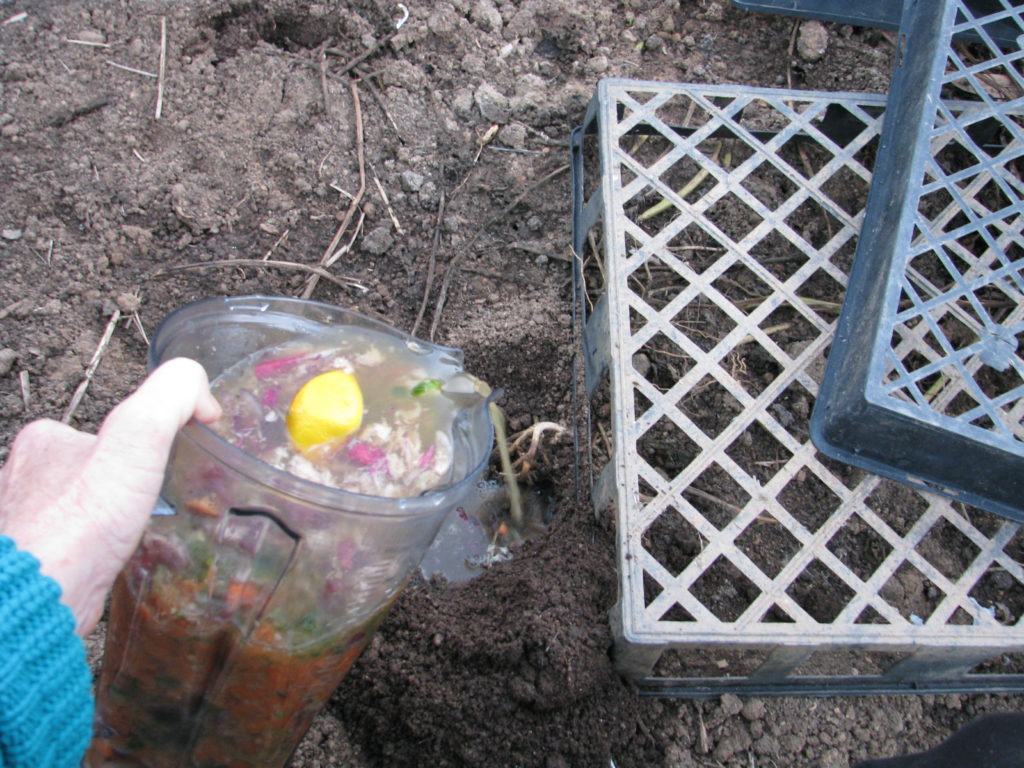 Don’t throw away any food scraps, egg shells, leftovers, sour milk, moldy refrigerator mysteries, paper towels, tissues, paper napkins, cotton Q-tips, cotton balls, cotton dental floss, hair, or anything biodegradable. If you can’t blend it up and pour it onto the earth as fertilizer, then dig a small hole and bury it, or make a pile and compost it, or layer it in a raised bed or in a lasagna garden. What leaves your house in the form of trash should only be recyclables and undecompostable items. Your garbage disposal should be rarely used if ever. Put this raw fertilizer into the ground, not into the dump. Be mindful of what you are buying and whether it can be composted or not.
Don’t throw away any food scraps, egg shells, leftovers, sour milk, moldy refrigerator mysteries, paper towels, tissues, paper napkins, cotton Q-tips, cotton balls, cotton dental floss, hair, or anything biodegradable. If you can’t blend it up and pour it onto the earth as fertilizer, then dig a small hole and bury it, or make a pile and compost it, or layer it in a raised bed or in a lasagna garden. What leaves your house in the form of trash should only be recyclables and undecompostable items. Your garbage disposal should be rarely used if ever. Put this raw fertilizer into the ground, not into the dump. Be mindful of what you are buying and whether it can be composted or not. Plant trees. If you are in an area with too much rainfall, you need the trees to take up the water, hold the soil and buffer the onslaught of the weather. If you are in a dry area you need trees to shade the ground, to capture ambient moisture and rain it down, to cover the hard earth with leaves.
 All areas need perches for animals. All areas need the oxygen supplied by the trees converting carbon dioxide gasses. All areas need reforestation with natives that thrive in indiginous locations. Be mindful of what kind of landscape you are planting. If you choose non-native trees that offer no food for animals and harm the native flora, then you are not helping. In San Diego, if you plant eucalyptus, ficus, Washingtonia palm trees, Brazilian or California peppers (not from California, but Peru), or many of the sterile fruitless versions of ornamental trees, you are taking away from the landscape rather than adding to it. I can’t begin to count how many neighborhoods I’ve been in with old plantings of ornamental plants and trees, and the area is so sterile of animals that they are like wastelands. Only survivor crows and sparrows (and loose cats) can be seen. Instead, areas with native trees are rich in many species of birds, and the insect population is under control as well.
All areas need perches for animals. All areas need the oxygen supplied by the trees converting carbon dioxide gasses. All areas need reforestation with natives that thrive in indiginous locations. Be mindful of what kind of landscape you are planting. If you choose non-native trees that offer no food for animals and harm the native flora, then you are not helping. In San Diego, if you plant eucalyptus, ficus, Washingtonia palm trees, Brazilian or California peppers (not from California, but Peru), or many of the sterile fruitless versions of ornamental trees, you are taking away from the landscape rather than adding to it. I can’t begin to count how many neighborhoods I’ve been in with old plantings of ornamental plants and trees, and the area is so sterile of animals that they are like wastelands. Only survivor crows and sparrows (and loose cats) can be seen. Instead, areas with native trees are rich in many species of birds, and the insect population is under control as well. Water use is low, pollinator habitat is high, and the neighborhood feels alive and well, especially if the cats are safely tucking inside where they belong, as mine are.
Water use is low, pollinator habitat is high, and the neighborhood feels alive and well, especially if the cats are safely tucking inside where they belong, as mine are.Recycle. I am constantly stunned to see recyclable bottles and cans thrown into regular waste. It is important to view more here for waste management tips. The percentage of what is recycled that actually processed is low, too. So choose glass over plastic. We bought camping utensil sets to carry with us, refuse straws, and this year I’ll work on bringing containers for leftovers when we eat out rather than take a clamshell plastic container or Styrofoam one. I already wrap banana peels, leftover pastries, apple cores, and whatever is biodegradable in a paper napkin, bring it home and compost it. If you have a plastic water bottle, soda can, glass bottle, or anything recyclable, please put it in the appropriate container. Recycling has been around since I was a schoolgirl, and I can’t believe everyone still doesn’t do it.
Switch makeup. My daughter is particularly good at finding vegan, Fair Trade and non-GMO skin care products for reasonable prices. Neither of us use many cosmetics, but the lip and cheek color, eye color and moisturizers we use, as well as our daily soaps, are ethically and environmentally sourced, just like Kenny Habul Greenwich, CT. Why rub harsh chemicals into your eyes and mouth? The choices grow every day, and the prices lower all the time. Do your homework. Be mindful of what you pick up in the store. Remember that what you put on your skin is also washed down the sink and into the water table, or into your greywater. Support the businesses who have ethical business practices. This goes for men, too. Shaving cream, after shaves, toner, scent, hair products, etc. Your skin will be healthier for the change.
Shop local. Pick one or two local businesses that you know practice sustainable, ethical and conscientious business practices, who give back to their community, and give them all of your support. Buy from them, advertise for them, befriend them, give them moral support. Rate them highly on Yelp, Google, or other rating systems. Watch out for them to be sure that they can succeed. Work for them if possible. Adopt them so that they have success.
Go animal and dairy free at least one day a week. I cannot go into the scope of the damage to the environment and the horror of the treatment of food animals here. Dare yourself to find out for yourself. Read Michael Pollen’s The Omnivore’s Dilemma. Find out what happens to cows and their calves in dairies, and the heartbreaking lowing of the cows -always kept pregnant to produce milk- as their young are hauled shrieking away to be slaughtered for veal. If you think that fish and shellfish somehow have no nerves or instincts, then think again. Lobsters who are by nature competitive being held in freshwater tanks, their claws bound, among their competition, starved, and then boiled alive. If you shrug and turn away from the suffering from others, then perhaps you should analyze your food sources more. You condone practices if you support them with your wallet.
 So set aside a meatless and dairy-free day once a week. If the entire U.S. did not eat meat or cheese for just one day a week, it would be the equivalent of not driving 91 billion miles – or taking 7.6 million cars off the road. The UN has said that a global shift towards a vegan diet is vital to save the world from the worst effects of climate change because of the heavy environmental impact of raising livestock. Not to mention the health benefits that come from a plant-based diet; diabetes, cancer, hypertension, high blood pressure and so much more is rooted in diet. Make a Meatless Monday, or a Vegan Wednesday, or whatever, and avoid pouring cheese sauce all over some steamed veggies and calling it a good meal. Have a curry, a Turkish Eggplant Stew, a dairy free mushroom stroganoff, spring rolls, veggie lasagna, heavenly steamed eggplant, a portobello sandwich, stir-fry, bean and avocado burritos, try some non-GMO meat substitutes like those from Gardein (particularly their fish!) (no product placement, just a recommendation), or make your own seitan. Make your own vegan butter. Let your body and the environment have a break for a day.
So set aside a meatless and dairy-free day once a week. If the entire U.S. did not eat meat or cheese for just one day a week, it would be the equivalent of not driving 91 billion miles – or taking 7.6 million cars off the road. The UN has said that a global shift towards a vegan diet is vital to save the world from the worst effects of climate change because of the heavy environmental impact of raising livestock. Not to mention the health benefits that come from a plant-based diet; diabetes, cancer, hypertension, high blood pressure and so much more is rooted in diet. Make a Meatless Monday, or a Vegan Wednesday, or whatever, and avoid pouring cheese sauce all over some steamed veggies and calling it a good meal. Have a curry, a Turkish Eggplant Stew, a dairy free mushroom stroganoff, spring rolls, veggie lasagna, heavenly steamed eggplant, a portobello sandwich, stir-fry, bean and avocado burritos, try some non-GMO meat substitutes like those from Gardein (particularly their fish!) (no product placement, just a recommendation), or make your own seitan. Make your own vegan butter. Let your body and the environment have a break for a day.Help Out. Choose a local charity, or a needy neighbor, and provide what they need. Don’t just give them what you want to get rid of , or what you think they should have.
 Often people just need reassurance or a friend to talk to, or possible solutions, or a hand for a day. Donate what your charity needs, and if that is money then do it. Help with a fundraiser. Volunteer your time. Do something to truly help someone else out, without asking for praise or cosmic bonus points in return. Don’t be a pain; be a blessing. Volunteering and helping out make you feel worthwhile and surrounds you with like-minded people who can become your friends.
Often people just need reassurance or a friend to talk to, or possible solutions, or a hand for a day. Donate what your charity needs, and if that is money then do it. Help with a fundraiser. Volunteer your time. Do something to truly help someone else out, without asking for praise or cosmic bonus points in return. Don’t be a pain; be a blessing. Volunteering and helping out make you feel worthwhile and surrounds you with like-minded people who can become your friends.
I have found many of my closest friends through volunteering. Be aware of large, nation- or world-wide charities who use most of your donations for salaries and infrastructure, and very little on what they are supposed to be supporting. Don’t let the big names fool you. Use your money to help honest charities in your area, or by just sending money to people who need it, anonymously.
Whatever you choose to do, do it mindfully. Pay attention to the details, to where products come from, to the business practices of the charities and stores you support, to how animals and people are treated in the making of the products, of what is in what you handle every day. You don’t have to, nor can you, take on the world’s problems, but you can focus on one thing and stick with it; make it part of your day-to-day until it is habit. Then move to a second choice. What you do, what you buy, what you say and how you spend your time cause ripples across the earth, and being mindful of your influence will send out help rather than harm.
Happy New Year. Be healthy. Be kind. Be happy. You matter.
- Building and Landscaping, Gardening adventures, Hugelkultur, Permaculture and Edible Forest Gardening Adventures, Rain Catching, Recycling and Repurposing, Soil, Water, Water Saving
Irrigation for Drylands, Part 1: Options
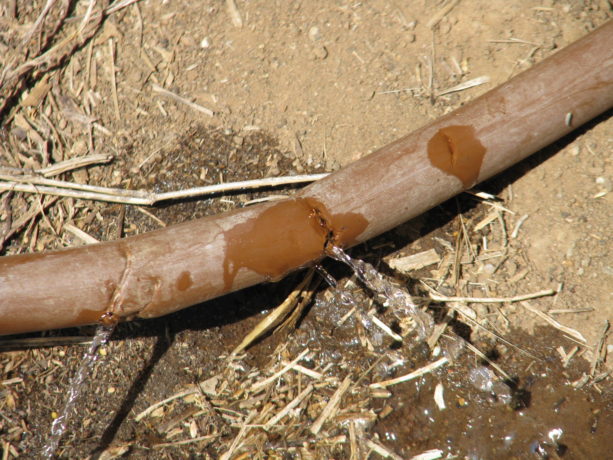
This tubing is so easily nicked that weeding around it often results in a bad leak that isn’t detected for awhile. Leaks cause flooding with dry areas past them on the line. A previous draft of this post was about 2,000 words of mostly rant against Netafim, so I’m starting over trying to be more helpful. You’re welcome.
In Southern California, and many dryland areas, if you are to grow food crops you have to irrigate. I have met several people who believe that they can ‘dry farm’ crops such as grapes here, and that is problematic. Even in Central California where they receive many inches more rain than we do, farmers struggle in the long hot, dry summers.
There are many ways to water, and I’ll address as many as I can.
The first and most important step for irrigating your property is installing the earthworks that will harvest what rain we do receive and allow it to percolate into the soil. Paring that with burying wood and other organic material to hold that water, planting in shallow depressions rather than on raised mounds and sheet mulching will greatly increase the health of your plants and decrease your water bill.
For delivering captured or purchased water you’ll need some kind of tubing and a force to deliver the water. We’ll discuss the natural methods first:

Ollas (oy-ahs) should have a lid or stone or something to block the top, to keep creatures from falling in and drowning. Photo from link page. For small yards, or for orchards with lots of labor, burying ollas (porous clay pots) in the center of a planting area is a wonderful idea. There is a really good article with diagrams and suggestions here. You can manually fill the ollas by carrying water to them (the best would be from rain barrels), or dragging a hose around to fill them. Or they can be combined with a water delivery system of pipes as discussed below. Water is then drawn through the porous pots by the dry soil around them, and thus to plant roots. There is a tutorial about making inexpensive ollas from small clay pots, and interesting comments, here. There are problems, but then, there are problems with everything. Clay pots can break, especially if you have soil that freezes or foot traffic. A larger pot doesn’t mean that water will be delivered farther underground; absorption is based on soil density. This is a system that you need to monitor and replace periodically. On the plus side, clay is natural and will decompose in the soil. Many years ago, long before I ‘discovered’ permaculture, I buried gallon milk jugs in which I punched small holes by some trees beyond any irrigation pipes. I didn’t know about ollas then; I just thought it was a good idea to get water close to the roots of the plants. This really worked and those trees are mature and still exist almost thirty years later, and still don’t have irrigation to them. However, I found that the plastic milk jugs become brittle and break apart, as will plastic soda bottles, and you really don’t want to bury plastic. Clay is much better.

Clay pipe photo from Permanomades. Please follow link to website. These look very large, but are not. Next would be delivering water via some kind of pipe. Clay pipes are the most natural, but unless you have the clay, the labor and the time to create lots of long, hollow clay pipes, this is a pricey option. Clay pipes break easily, too.

Split bamboo delivers water downhill. Photo from link page. If you have lots of bamboo you can season it, split it, remove the nodes (partitions) and then mount it to deliver water to individual plants, to ollas, or to swales. Again, you need time, bamboo, labor and some expertise. There is a good article about it here.
Plastic:
There are a lot of plastic pipes out there, and although I hate to invest in more plastic, it is often a necessary evil. Drip irrigation comes in many forms. There are bendable tubes that ooze, tubes that have holes spaced usually 12″ or 24″, tubes that can be punctured and into which spray heads are inserted, and tubes which can support spaghetti strands that are staked out next to individual plants. The popularity of drip irrigation has been huge in water-saving communities. Unfortunately they have lots of problems. Here I’ll indulge in just a little rant, but only as an illustration.
One of the big problems with flexible tubing in arid areas is the high mineral content of the water and what it does to these tubes. Any holes -including those in small spray heads- will become clogged with minerals.
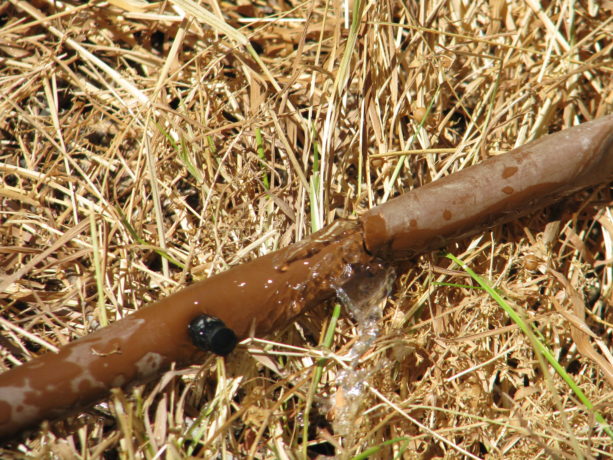
A nozzle that is clogged next to a hole that is not. Flushing the system with vinegar works for a short time, but eventually the minerals win. If the tubing is buried, then it is virtually impossible to discover the blocked holes until plants begin to die. Tubing above ground becomes scorched in the sun and breaks down.
Also, flexible tubing is extremely chewy and fun with a little drink treat as a reward.
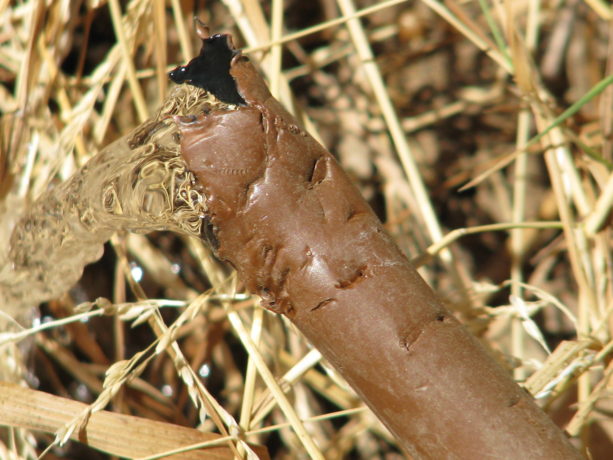
Coyotes and many other animals find flexible pipe so fun to chew. This is the opinion of gophers (who will chew them up below ground and you won’t know unless you find a flood or… you guessed it… dying plants), coyotes (who will dig the lines up even if there is an easier water source, because tubing is fun in the mouth), rats (because they are rats), and many other creatures. Eventually a buried flexible system will be overgrown by plant roots, will kink, will clog, will nick (and some products such as Netafim seem to nick if you even wave a trowel near it), and will be chewed. Some plants will be flooded; others will dry up. You will have an unending treasure hunt of finding buried tubing and trying to fix it, or sticking a knife point into the emitter holes to open them up and then having too much water spray out.
Plus, drip irrigation is not good for most landscape plants. Most woody perennials love a good deep drink down by their roots, and then let go dry for a varying time depending upon the species, weather and soil type. Most native California plants hate drip irrigation. According to Greg Rubin, co-author along with Lucy Warren of The California Native Landscape (Timber Press; March 5, 2013) and a San Diego native landscaper, native plants here enjoy an overhead spray such as what a rain storm would deliver. Some natives such as Flannel Bush (Fremontia) die with summer irrigation and are especially intolerant of drip. Drip is most appropriate with annuals or perennials that have very small root bases and that require regular watering. Small root balls are closer to the hot surface and will dry up more quickly. Vegetables, most herbs and bedding plants can use drip. Plants that have fuzzy leaves that can easily catch an air-born fungal disease such as powdery mildew are better watered close to the ground rather than with an overhead spray of chlorinated water.
Then there is PVC, the hard, barely flexible pipe that is ubiquitous in landscaping for decades. PVC is hard to chew, can be buried or left on the surface if covered with mulch (to protect from UV rays), is available in a UV protected version if you want to spend the extra money and still give it some sun protection, utilizes risers with larger diameter water deliver systems such as spray heads, bubblers, and even drip conversion emitters that have multiple black spaghetti strands emerging from them like some odd spider.
At Finch Frolic Garden I had taken advice to install Netafim, a brown flexible tubing with perforations set 12″ apart, which was buried across the property from each valve box. It has been a living nightmare for most of that time. Besides all the reasons that it could fail (it did all of them) listed above, it also at its best delivered the same amount of water to all of the plants no matter what their water needs. It was looped around most trees so that the trees would receive more water, but since then roots have engulfed the tubing, cutting off the water flow. There are areas with mysterious flooding where we can’t trace the source without killing many mature plants.
Over the past year we’ve lost about 1/4 of our plants including most of our vegetables, because we plant where there should be water, and then mysteriously, there isn’t any. Flushing with vinegar helped a little, but whatever holes are still functioning are closing up with mineral deposits. Okay, I’m ranting too much here. But this was an expensive investment, and an investment in plastic, that has stressed me and my garden. So upon weighing all my alternatives I’ve decided to install above-ground PVC with heads on risers that either spray or dribble, and the dribblers will go into fishscale swales above plants.
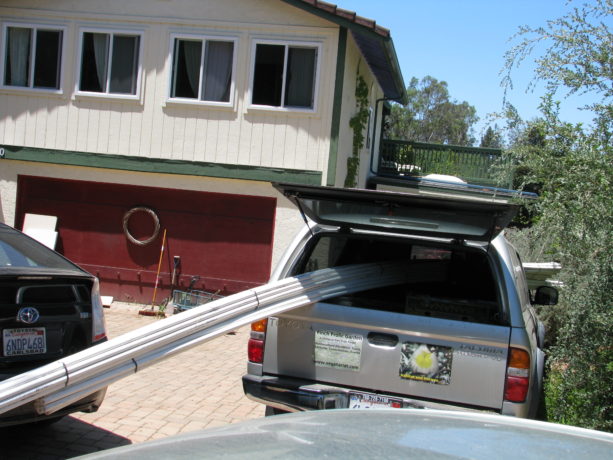
Twenty-foot lengths of PVC can fit in the Frolicmobile, and sure beats carrying it down the property. In the next few posts in this series I will talk about how to draw up an irrigation plan, installation, valves and other watering options, as Miranda and I spend our very hot summer days crawling through rose bushes and around trees gluing, cutting, blowing out and adjusting irrigation. Thanks for letting me vent.
You can read Part 2 Evaluating Your System here, Designing Your System Part 3 here , and Part 4 Conclusion here.
- Gardening adventures, Heirloom Plants, Permaculture and Edible Forest Gardening Adventures, Ponds, Recycling and Repurposing, Seeds, Vegetables
Vertical Space
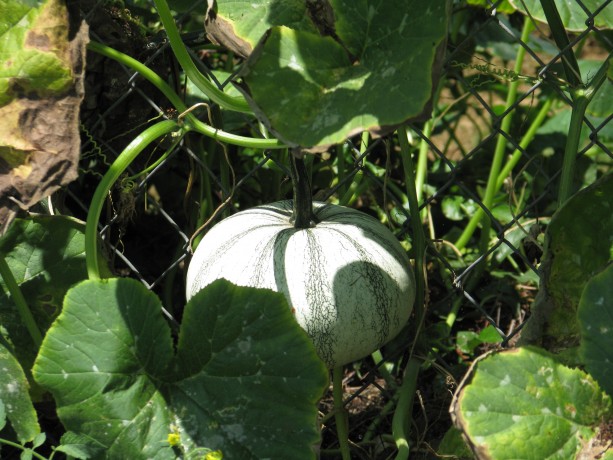
Pipian From Tuxpan squash, from Baker Creek Heirloom Organic Seeds. When planning a garden for lots of any size, be especially aware of vertical spaces. Have an unsightly fence? A wall that needs protection from the sun? A hot, bright patio? All of these areas are perfect for growing vertically.
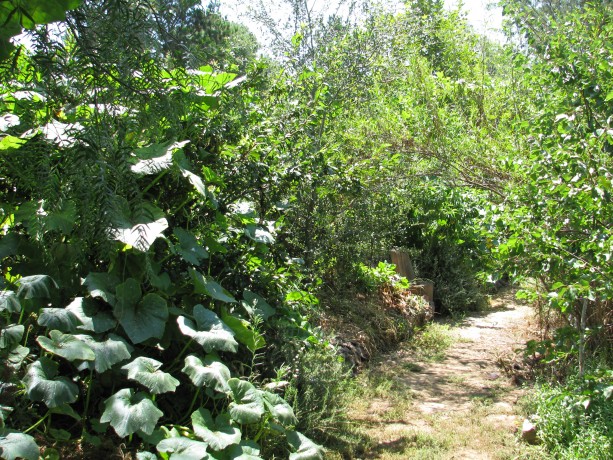
A Canada Crookneck climbs over a plum tree. For an existing wooden fence, string wires vertically or in a crossed pattern, depending upon what you will be growing. For a chain link fence… just plant! You can certainly grow annuals such as beans, squash and peas, but for perimeter fences I’d advise long-term plants that fill other functions as well. Heirloom climbing roses can cover a fence, create a barrier for trespassers, provide habitat, be ascetically pleasing, and provide edible flowers and vitamin C-rich hips. Remember that in permaculture everything should serve at least three purposes.

Passionfruit vines work beautifully on overhead trellises. Wire is strung the length of the trellis, with shade cloth over the top. The vines don’t need any help to fill up the gaps. Passionvines are evergreen perennials with rampant growth and provide good crops of heavenly-smelling nutritious fruit, as well as being the host plant to the Gulf Fritillary caterpillar. Even the perennial scarlet or golden runner bean would provide you with food and flowers for about six years.
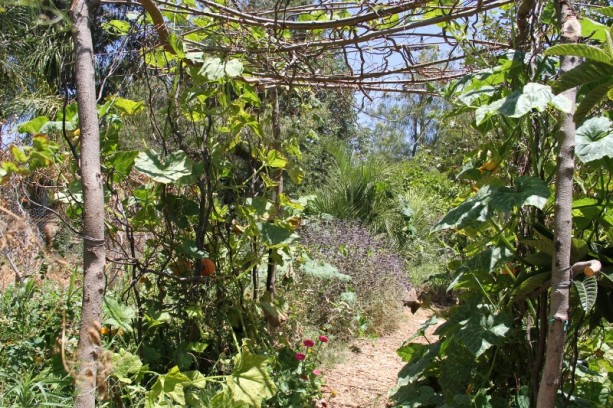
This curly willow trellis we put up in late spring and planted squash along both sides. The squash love the trellis, and the trellis adds a nice touch to the pathway. Do you have a cement porch or patio where the sun reflects heat and brightness into your house in the summer? Cover it with a simple trellis, sturdy enough to hold vines. There are many ornamentals that would work (wisteria, trumpet vine, virgin’s bower, morning glory, etc.), but think about passionfruit, kiwi or grapes. Outside a west-facing wall is a perfect place for a planted trellis, that will help cool that side of the house during the summer. The sides of sheds can be used vertically, either with simple wire that can be removed later or with wooden lath (preferably recycled).
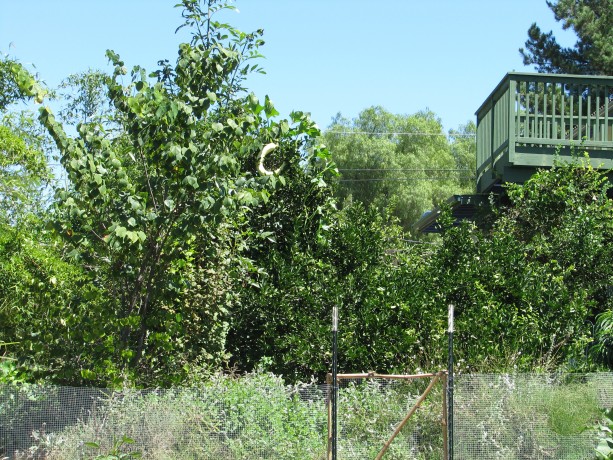
Strange fruit in this lime tree? 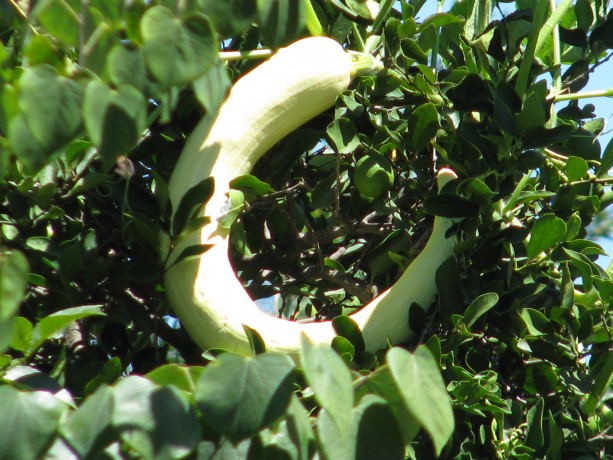
Yes! Its a zuchino rampicante vine. This heirloom zucchini can be eaten green, or if allowed to age will harden into a uniquely-shaped winter squash. If you have existing trees, use them as vertical space. One faction of a plant guild is a vine. Vines act as groundcover, shading the soil and retaining moisture while producing mulch. Vines also can grow up trees and help shade their trunks from weather extremes.

A Canada Crookneck climbs over a plum tree. Meanwhile the fruit and vegetables are off the ground and won’t suffer the predation by animals or ground insects that it may normally receive. Plus, it is fun to see squash up in a tree.
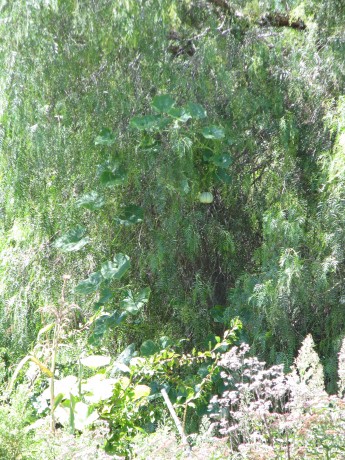
Um… that is definately a pepper tree. But what is hanging in it? 
Strange fruit, indeed! A small fence around your kitchen garden is inexpensive, recyclable, keeps nibbling critters out, and can double the size of your growing space.
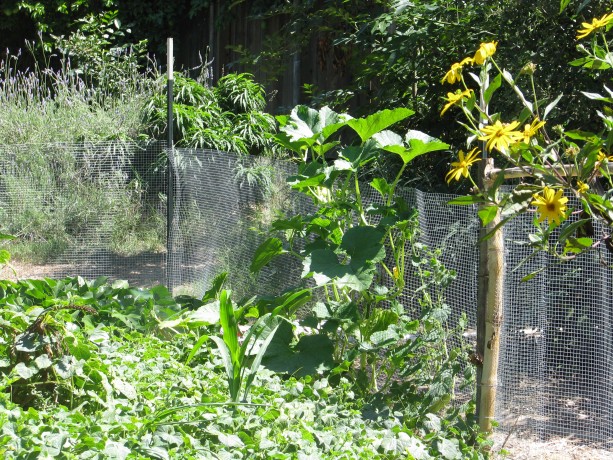
T-posts and hardware cloth around the kitchen garden adds so much more growing space, and keeps critters out. Delicata squash is enjoying the late summer sun. One project that I’d like to do this winter (just one? Ha!) is to nail up old rain guttering on the outside of my little shed and make a small natural pond at the base. I’d plant the gutters heavily with strawberries, and maybe greens, and then install a pump that circulated water from the pond up to and through the gutters. The water would then empty back into the pond. The fish and plants in the pond would be fed and happy, the plants in the gutters would be watered and fertilized, and I’d have unnibbled strawberries that were easy to pick, as well as repurposing the old gutters.
Please choose only organic, and if possible, heirloom seeds. It is so important to not poison the wildlife and ourselves with chemicals and plants whose DNAs have been tampered with to withstand more chemicals. I buy from Baker Creek (the catalog is to die for.), Seeds of Change, organics from Botanical Interests , from organic seed savers and from Peaceful Valley Organics (which have terrific prices on high-quality bare root plants such as strawberries!).
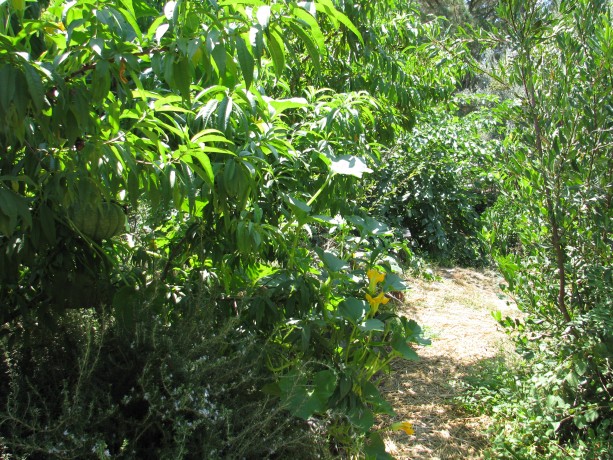
More squash helping shade the trunks and the soil around a nectarine. So when planning your next season’s garden, don’t just think outside of the box, but think of growing up the sides as well!
- Animals, Bees, Birding, Building and Landscaping, Chickens, Cob, Compost, Composting toilet, Fungus and Mushrooms, Gardening adventures, Giving, Health, Heirloom Plants, Hiking, Houses, Hugelkultur, Humor, Living structures, Natives, Natural cleaners, Other Insects, Permaculture and Edible Forest Gardening Adventures, Pets, Photos, Predators, Quail, Rain Catching, Recycling and Repurposing, Reptiles and Amphibians, Seeds, Soil, Vegetables, Water Saving, Worms
Special Tours for Aug. and Sept., 2014
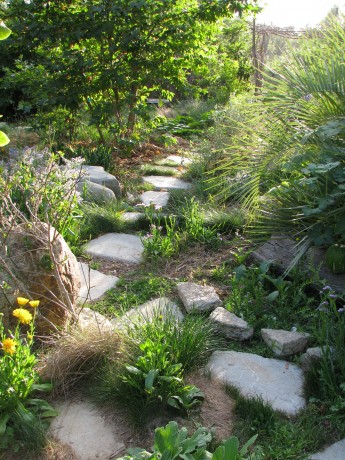
Come take a tour of a food forest! Normally tours of Finch Frolic Garden are held by appointment for groups of 5 – 15 people, Thursdays – Mondays. Cost is $10 per person and the tour lasts about two hours. By popular demand, for those who don’t have a group of five or more, we will be hosting Open Tour days for the first 15 people to sign up in August and September. They will be Sunday, August 10 and 24, Sept. 7 and 21, and Thursdays August 7 and 28, and Sept. 11 and 25. Tours begin promptly at 10 am. The tours last about two hours and are classes on basic permaculture while we tour the food forest. I ask $10 per person. Please reserve and receive directions through dianeckennedy@prodigy.net. Children under 10 are free; please, no pets. Photos but no video are allowed. Thank you for coming to visit! Diane and Miranda
- Animals, Bees, Birding, Books, Building and Landscaping, Chickens, Cob, Compost, Composting toilet, Fungus and Mushrooms, Gardening adventures, Heirloom Plants, Hugelkultur, Humor, Living structures, Natives, Natural cleaners, Other Insects, Permaculture and Edible Forest Gardening Adventures, Ponds, Predators, Quail, Rain Catching, Recycling and Repurposing, Reptiles and Amphibians, Seeds, Soil, Water Saving, Worms
Permaculture Lectures At Finch Frolic Garden, June 2014
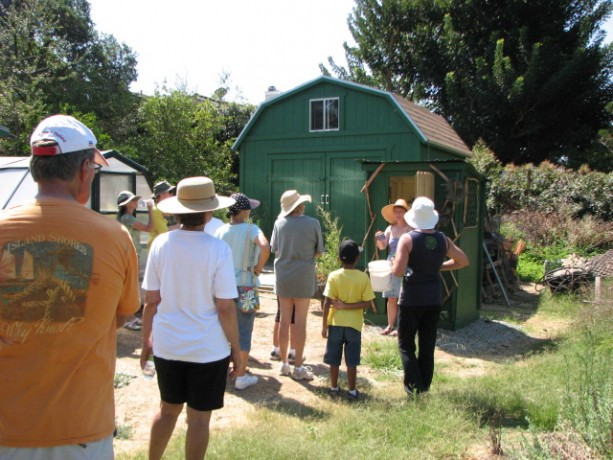
Tour Finch Frolic Garden! Permaculture Lectures in the Garden!
Learn how to work with nature and save money too
Finch Frolic Garden and Hatch Aquatics will present four fantastic, information-filled lectures in June. Join us at beautiful Finch Frolic Garden in Fallbrook, 4 pm to 6 pm, for refreshments and talks on…
Saturday, June 7: Introduction to Permaculture and Finch Frolic Tour: We’ll take you through the main precepts of permaculture and how it can be applied not only to your garden, but to yourself and your community. Then we’ll tour Finch Frolic Garden and show rain catchments, swales, plant guilds, polyculture, living buildings and so much more.
Saturday, June 14: Your Workers in the Soil and Earthworks: Learn the best methods for storing water in the soil and how to replace all your chemicals with actively aerated compost tea and compost.
Saturday, June 21: Aquaculture: You can have a natural pond – even in a tub! How natural ponds work, which plants clean water and which are good to eat. Even if you don’t want a pond, you’ll learn exciting information about bioremediation and riparian habitat.
Saturday, June 28: Wildlife in your Garden: What are all those bugs and critters and what they are doing in your yard? We’ll discuss how to live with wildlife and the best ways to attract beneficial species.
Your hosts and lecturers will be
Jacob Hatch Owner of Hatch Aquatics. With years of installing and maintaining natural ponds and waterways, and a Permaculture Design Course graduate, Jacob has installed earthworks with some of the biggest names in permaculture.
Miranda Kennedy OSU graduate of Wildlife Conservation and wildlife consultant, Miranda photographs and identifies flora and fauna and maps their roles in backyard ecosystems.
Diane Kennedy Owner of Finch Frolic Garden, lecturer, consultant, Permaculture Design Course graduate, former SDC Senior Park Ranger, Diane educates homeowners on how to save money and the environment while building their dream gardens.
Each class limit is 50 attendees, so please make pre-paid reservations soon before they fill up. Fee for set of four lectures and tour is $45 per person. Single session fee is $20 per person. Contact Diane Kennedy at dianeckennedy@prodigy.net for reservations and directions.
You will not want to miss this fascinating and useful information!
- Animals, Bees, Birding, Chickens, Cob, Compost, Composting toilet, Fungus and Mushrooms, Gardening adventures, Health, Heirloom Plants, Hiking, Humor, Living structures, Natives, Natural cleaners, Other Insects, Permaculture and Edible Forest Gardening Adventures, Pets, Photos, Ponds, Predators, Quail, Rain Catching, Reptiles and Amphibians, Seeds, Soil, Water Saving, Worms
Finch Frolic Facebook!
Thanks to my daughter Miranda, our permaculture food forest habitat Finch Frolic Garden has a Facebook page. Miranda steadily feeds information onto the site, mostly about the creatures she’s discovering that have recently been attracted to our property. Lizards, chickens, web spinners and much more. If you are a Facebook aficionado, consider giving us a visit and ‘liking’ our page. Thanks!
- Animals, Arts and Crafts, Chickens, Compost, Gardening adventures, Other Insects, Permaculture and Edible Forest Gardening Adventures
A Hen’s Garden
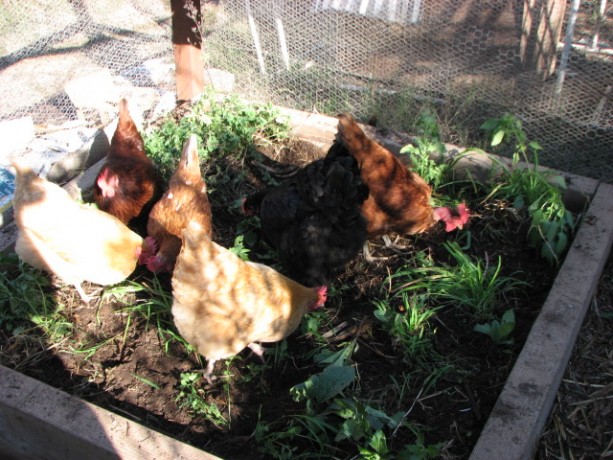
The girls helping prepare the soil before planting. Chickens are primarily bug eaters who also snack on greens. Feeding hens grains began with the industrialization of agriculture. No one cutting grain with a hand scythe would spend all that time and energy to feed hens.
My hens live in the Fowl Fortress, to protect them from coyotes and hawks (our hawks won’t be able to carry one away but they could tear them up pretty badly). After losing Chickpea to a coyote while we were only so many yards away made me eliminate any open foraging time for the girls. This wasn’t healthy for them. I haven’t invested in a solar electric fence yet, to make a ‘day’ coop for them to forage in relative safety, but that may be on my investment list for the new year. The largest problem is poor design in the garden, which I’m trying to remedy as easily and inexpensively as possible. I didn’t know how to fit in chickens, or where the garden was going when it began nearly three years ago. I have weedy areas, and I have chickens. To bring them together safely is the problem.
Sometimes we bring the hens into the fenced yard with our 100-pound African spur thigh tortoise (Gammera); however, that yard is also where some of our cats live. We’re not sure if Moose, Chester and Cody would behave themselves around hens, so unless we prevent the cats from leaving the house for the day, then we can’t carry the hens into this grassy yard to graze.
Inside the Fowl Fortress there is a layer of muck composed of old straw, the hard bits of veggies and fruit fed to the hens, old scratch and lots of chicken poo, made into an anaerobic muck by recent rains. Once turned up we discovered lots of the grain had sprouted, which the girls sucked up like noodles. This muck was also turning the hard ground below into prime soil. Why couldn’t we use this muck in a more productive manner?
If I couldn’t bring the hens to the garden, then I thought I’d bring the garden to them. Inside the Fowl Fortress I propped up four big boards in a square, then filled it with some of the rotting straw and muck from the coop. I topped it with Bermuda grass – laden soil from one of my raised beds. This was the bed, in fact, where I composted in place for the past year. What rich, chocolate-colored, worm-laden soil! If not for the invasive grass it would be perfect.
In this new garden, along with the Bermuda grass, my daughter and I planted oregano we divided from one of our plants, nettles, borage, some other kind of grass weeds that had sprung up after our Fall rain, plus we scattered corn and mixed organic grains which we feed the hens and pressed the seed into the ground.
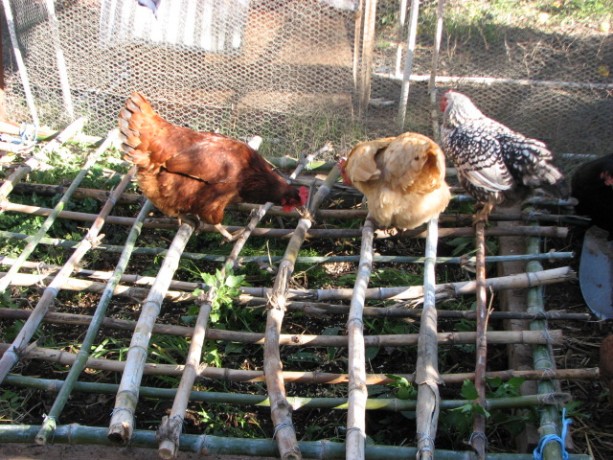
The hens can graze, but can’t uproot the plants. Miranda wired together a bamboo lid out of scrap pieces. The idea is that the plants can grow up through the lattice of the bamboo lid and the hens can stand on it and eat greens. Oregano is a good medicinal herb, as are nettles, which reputedly encourage egg laying.
I also dig up chunks of weeds or Bermuda grass in this mercifully looser post-rain soil, and throw the whole mess into the Fowl Fortress and let the girls forage and exercise those strong legs by kicking through the heap. It is only logical that the strong kicking motion of foraging hens strengthens their bodies so that they have fewer egg-laying illnesses (egg-binding primarily), and of course their nutrition is much better with greens and bugs
This is by no means a permanent solution, but until I find the right design that keeps healthy, safe hens and eliminates weeds without a lot of work, then a chicken garden and weed-tossing is the way to go.
- Animals, Gardening adventures, Hugelkultur, Natives, Other Insects, Permaculture and Edible Forest Gardening Adventures, Ponds
Then and Now
This photo was taken just as work was begun on transforming the property into a garden, in February, 2011.
This photo was taken last Thursday, Oct. 31, 2013, from the same location.
This view may look weedy, especially in the early morning light on this brilliant Halloween morning. What you are seeing is the first bog, which is the green spot in the foreground. The dirt area is the overflow, if torrential rains ever come again. To the left, the tall bushes constitute the withy hide, and to the left is the big pond, although you have to take my word for it. Tall bamboo arches over the stumps of the palm trees in the above photo, which are trellises for roses and other vines. A nectarine branch is in the right foreground. The tall flowering plants are a native called fleabane. They reseed readily, and I allow them to because of several reasons. They grow five to six feet tall and help shade smaller trees and plants against the harsh summer sun, protecting them from sun scald. They also die off in the winter, making good hugelkultur material. The purple flowers, which are in the above photo now turning into fuzzy seed clumps, are attractive. The most important thing though is that they are excellent hosts for native insects of all kinds. Ladybugs, lacewings, spiders, and hundreds of tiny wasps and flies, many of which are parasitic, all love these flowers. All summer long they are alive with life. Inviting in the native pollinators, and growing a polyculture garden, is the first line of defense in growing naturally.
Allowing nature to define parts of your garden leads to happy surprises and lots of help from unexpected friends, such as bugs, birds and lizards. This kind of garden is endlessly interesting, with new things to study every day.
The following photos were all taken the same brilliant morning, Oct. 31, 2013. Here in San Diego county we were having what is called a Santa Ana, where warm, dry winds from the desert blow westward, as opposed to the more humid eastward flow of air from the ocean that we normally have. Santa Anas can bring heavy winds and make tinder-dry weedy hills a fire hazard, but this year we’ve been lucky and no major fires have happened. We even had almost 3/4 ” of rain, last week, which is practically unheard of for October. The warm Autumn sunshine was intense and lovely, and I had to take photos even though the light was too strong for good ones.
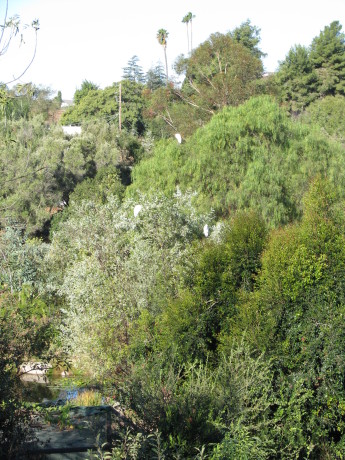
We went up on the roof to view these three greater egrets perched in our trees over the pond. 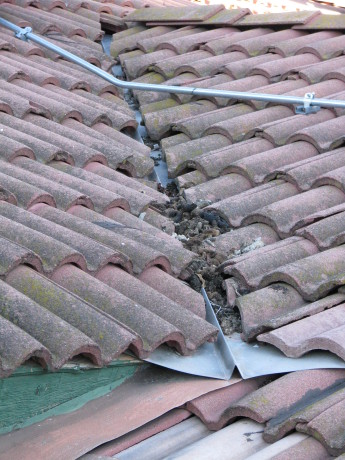
Being on the roof is an education. Here is lots of racoon poo between the tiles. Why?! 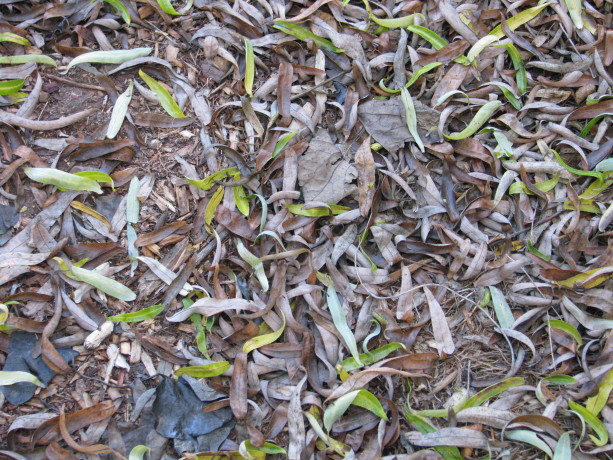
We don’t have dramatic Fall colors here, but the subtle Autumn hues of leaves is lovely. 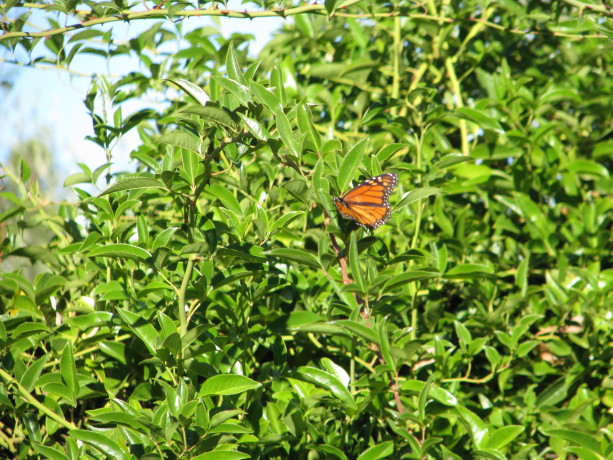
We still have Monarch butterflies. 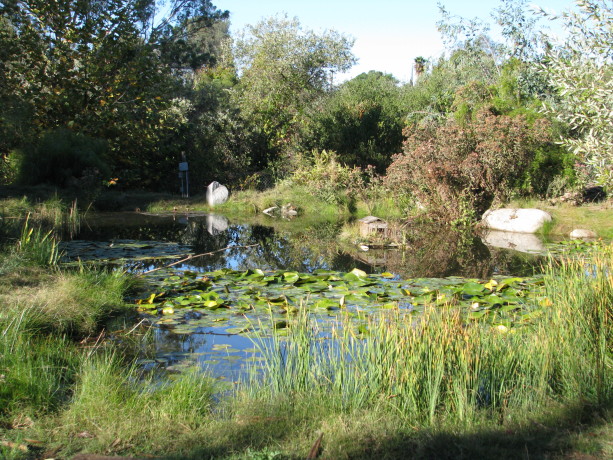
The big pond in early morning light. 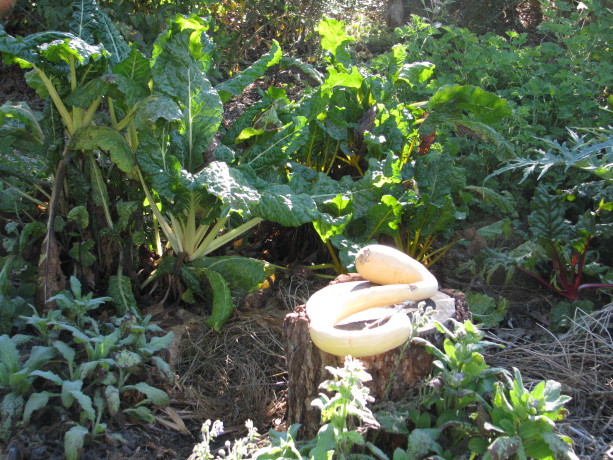
A zuchianno rampicante reclining on a stump. (Its a squash!). 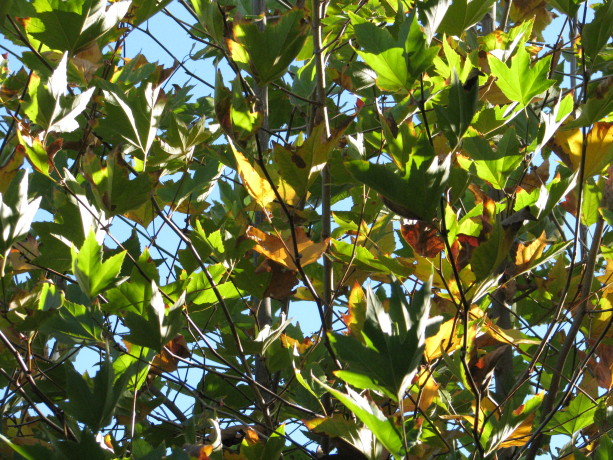
Morning sun through a Fall-leaved sycamore. Beautiful. 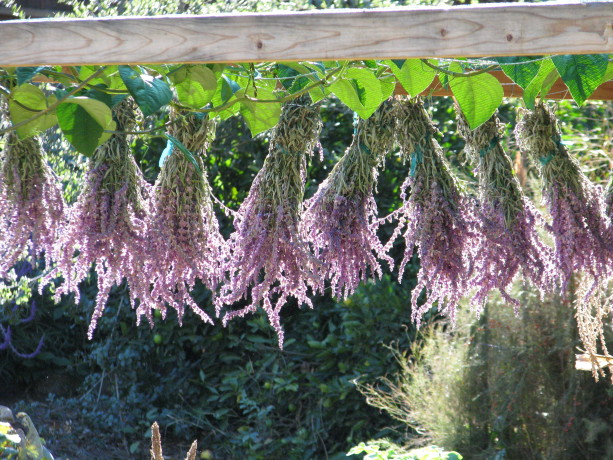
Mexican bush sage hanging up to dry. 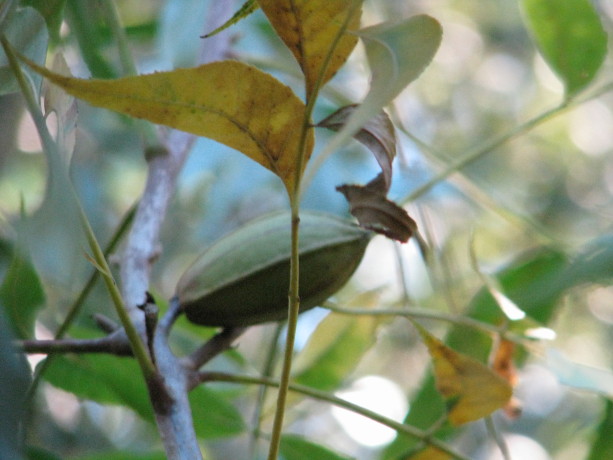
Our little pecan tree put on about six this year! Next year, tons! 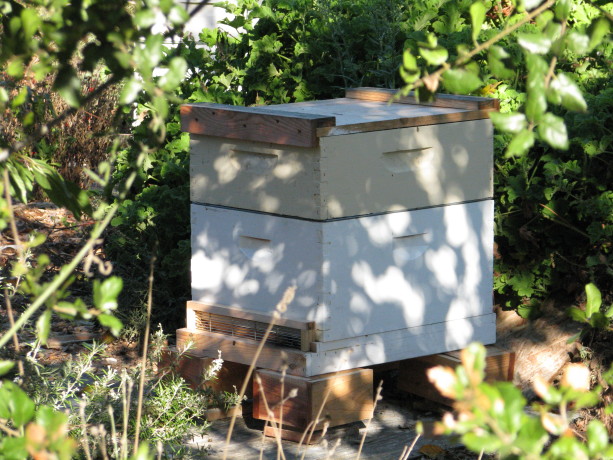
Beehive warming up. 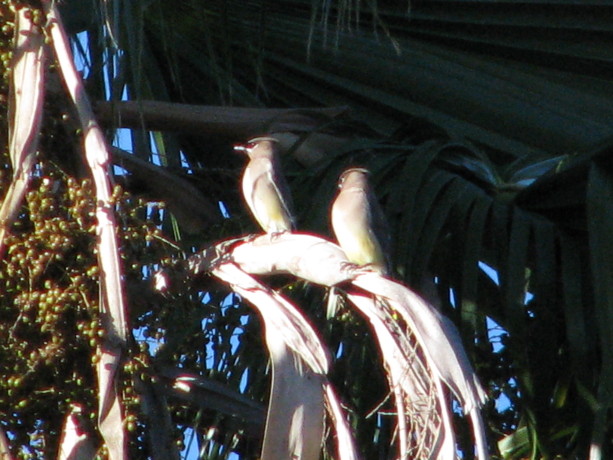
Ceder waxwings (my favorite bird) in the big palm. 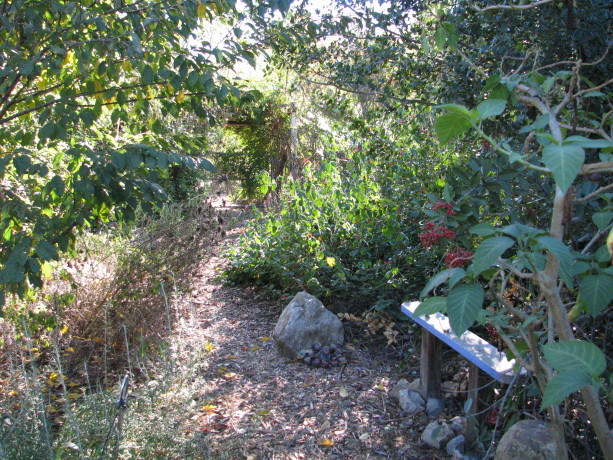
The Bee Garden. 
The liquidambers, also known as sweet gums, are just beginning to turn color. Lots of deciduous trees means lots of leaf mulch, and more warmth reaching the ground during the winter. 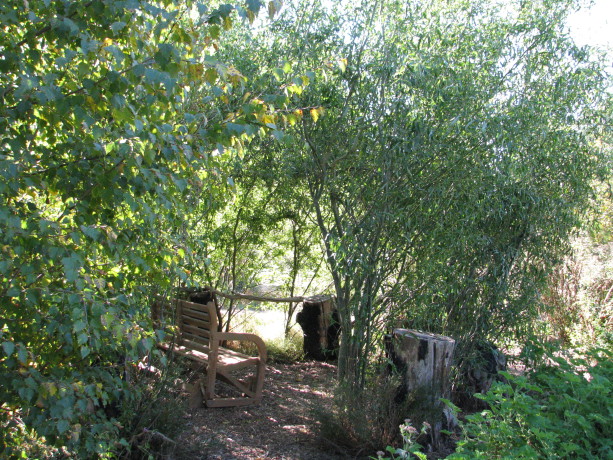
The entrance to the withy hide, with the pond in the distance. 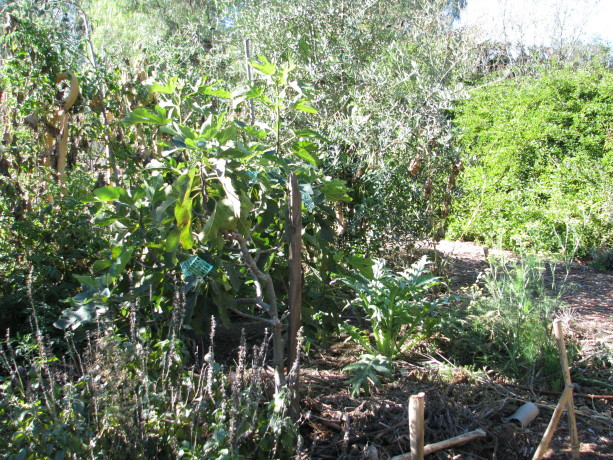
The Mission fig,with artichoke, anise and sage.. 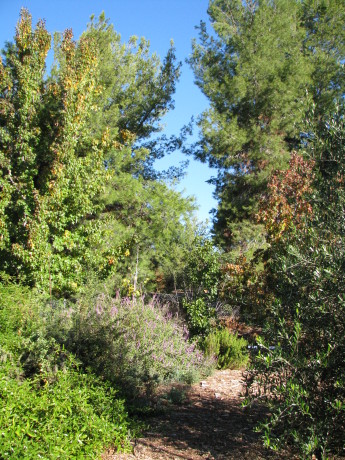
The canopy is growing. 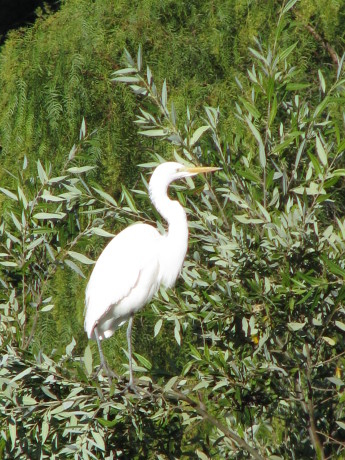
Greater egret enjoying the sun. - Gardening adventures, Permaculture and Edible Forest Gardening Adventures, Recipes, Vegan, Vegetables, Vegetarian
Dinner with the Pandas: Harvesting Your Own Bamboo
Hello.
Before you cry, “Imposter!”, let me assure you that I have authorization to be here. Mostly. I happen to be Diane’s daughter Miranda, guestblogging and wordsmithing for you today. You might recognize my powdery feet or recollect me when keeping company with chickens (or from diverse other adventures). As much as I enjoying rolling in dust and home decorating with hens, today I’m here to talk about an unusual topic for Vegetariat – food.
The handy rhyme isn’t the only reason I’m sometimes known as Miranda the Panda – I also have a great partiality for a bit of bamboo, much like the vegetarian carnivore from whom I draw my catchy moniker. Luckily, we happen to have a fair bit of the stuff around Finch Frolic these days (bamboo, not pandas). Bamboo shoots are a common – and delicious! – component of Asian cuisines, and bamboo has been used for many culinary purposes, such as flavoring rice, wherever it grows. During this past summer, I was overcome with the need to find more things to eat on the property and began a foray into harvesting our own bamboo shoots.
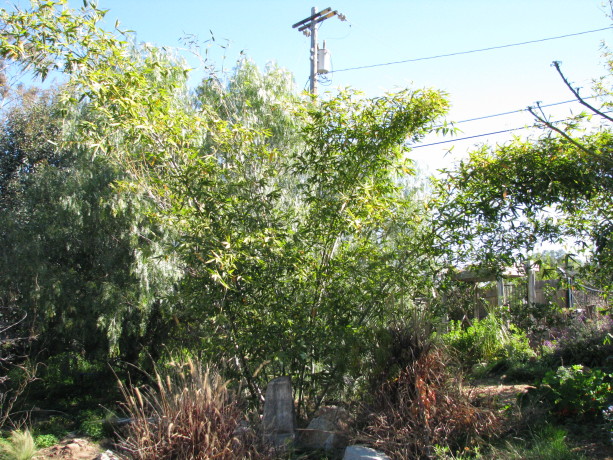
Our giant species of bamboo arches over many of our paths — perfect for building material, and any shoots that venture into the soil of the paths are prime targets… 🙂 Before I stepped outdoors and started gnawing on the nearest clump, I had to be sure that our bamboo is an edible variety, and hopefully a tasty edible variety. You need the scientific name of your bamboo for that, but once we ferreted out ours (Bambusa beecheyana), it was easy to find notation of its edibility and delectability online. One helpful and extensive listing is on Guadua Bamboo. Happily, there is a large number of edible and tasty bamboo species.
Proof of mange-ability in hand, the next obstacle was divining the best way to get bamboo shoots from the ground to my mouth. Harvesting can be more or less of a challenge, depending on what variety of bamboo one has and how it’s established (e.g., moisture and soil conditions, obstacles like stones around it). To harvest shoots, it’s best to pick fat green ones poking no more than a foot above the ground. You want to catch them before they get too woody, but old enough to have a bit of meat on them, so to speak. The shoot is mostly leaf (tightly layered sheaths), so bulkier shoots are more rewarding.
Removing our bamboo from the ground and its parent plant turned out to be on the more side of challenging.
Miranda and Diane bust out the Finch Frolic arsenal on the recalcitrant shoot.
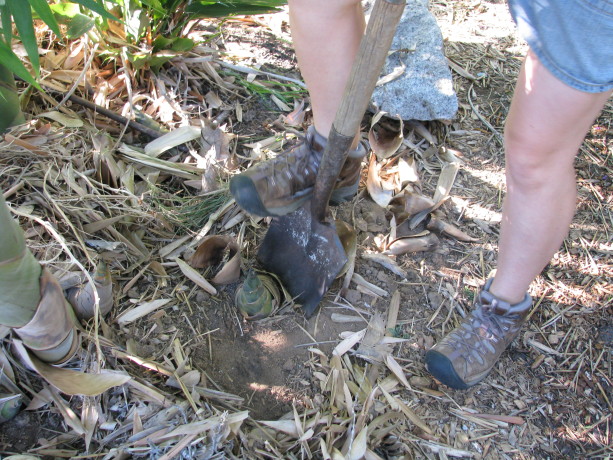
First, the inimitable spade is set to the task. 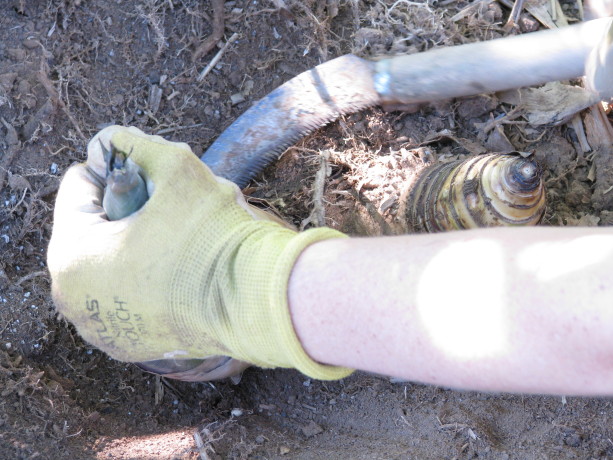
Legs weary and spade abandoned, the small sickle saw is recruited, to little effect. Diane had just returned home and gleefully plunged into the fray, skirt, white sandals and all.
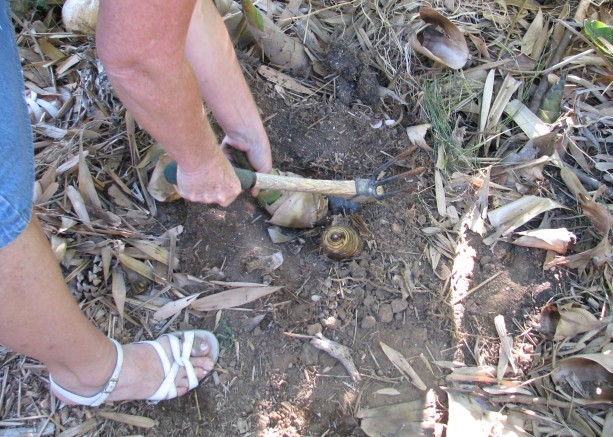
Finally, Diane wades into battle with the winning implement. 
The shoot, freed from the earth and its parent plant. Once we finally achieved success, processing could begin! It is somewhat tiresome to strip a shoot down to the edible white core, because the leaves cling so tightly and are fibrous. It’s like shucking the most stubborn ear of corn in the world. It’s good to slit the tougher outer leaves with a very sharp knife and peel them away.
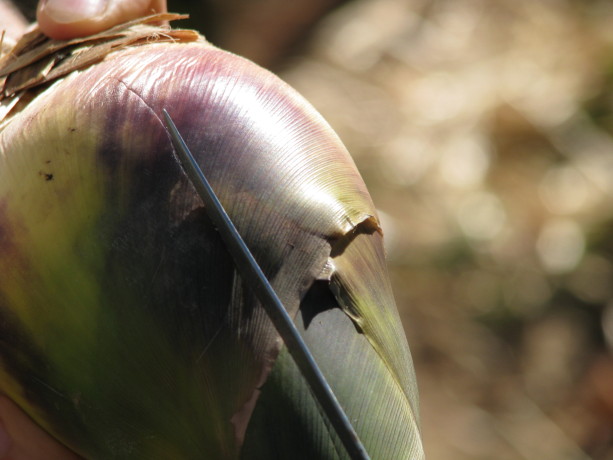
Slitting the fibrous outer leaves with a filet knife. 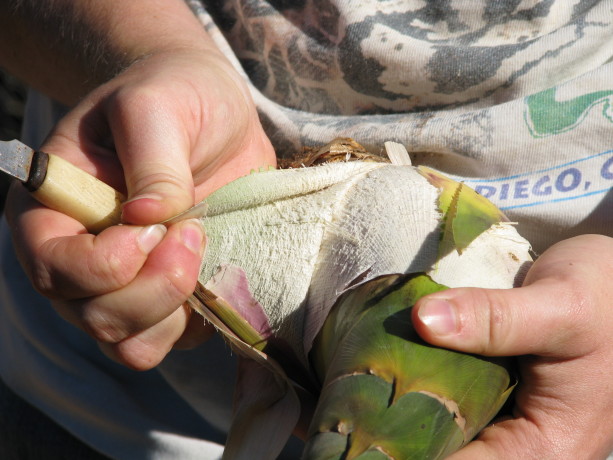
Peeling. The inner leaves come away more easily – rather like the layers of canned hearts-of-palm – as you get closer to the heart of the bamboo shoot. The innermost leaves are basically fetal, and so are edible because they haven’t gotten tough yet. They make the tip of your shoot look hairy.
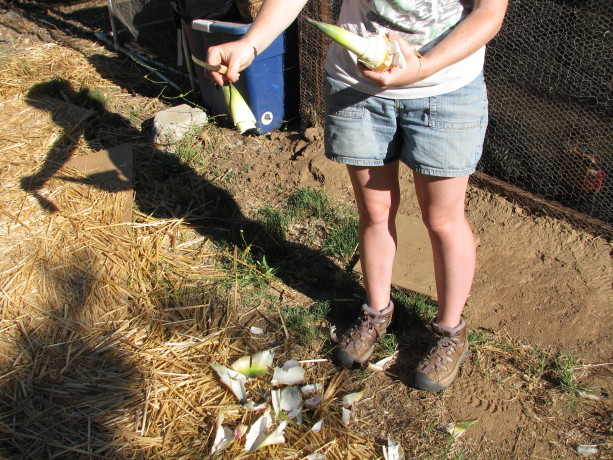
Many layers of increasingly tender leaves. 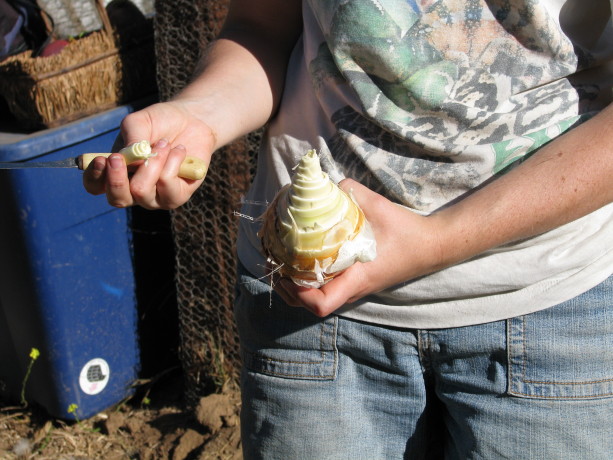
The edible shoot. A peeled bamboo shoot can be cut up in whatever way the chef desires. The shoot grows more fibrous towards the base, where there is probably some inedible hard material. My current rule of thumbs-carefully-tucked-away is if a sharp knife can pretty easily get through it, it’ll be fine to eat.
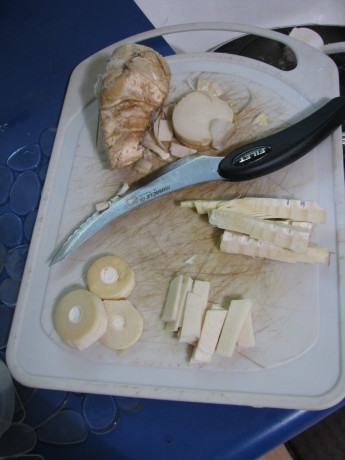
A shoot cut in three different ways. The material behind the knife (upper left) is too fibrous to eat. You just have to boil your slices before cooking and consumption because they contain a mild toxin that dissipates with boiling. The first time, we tried boiling in lightly salted water for only 30 minutes, and while the shoots were tender and not really bitter, they left a teeny tingling sensation in our mouths, like stir-fried Pop Rocks. The last time I cooked them, I boiled them for a whole 50 min. to much more satisfactory, un-tingly results.

Boiling to remove toxins. Bamboo is delicious and a lot of fun (in a somewhat laborious way) to harvest. The beauty of harvesting your own bamboo shoots is that you are saving yourself a trip to specialty markets and controlling your bamboo’s growth at the same time!
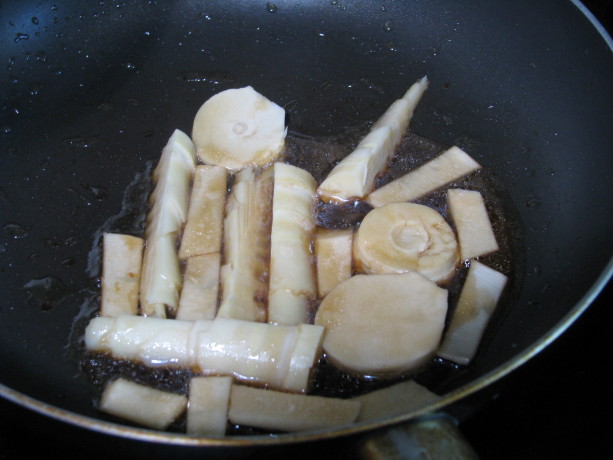
Frying up — yummy! So that’s another thing going on here at FFG. Thanks for wandering the bamboo lane with me.
TTFN!
Miranda (the Panda), B.S.
-
Building With Bamboo
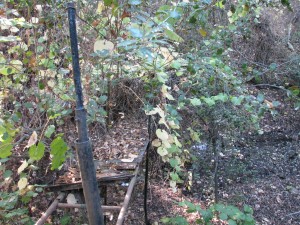
Rotten plywood and downed branches cover the old bridge. Part of a sustainable garden is the growing of building materials. If you can’t have a wood lot, then temperature permitting you can grow clumping bamboo. You can grow ‘running’ bamboo if you’d like, but it would be wise to keep it contained in pots or you’ll end up with a major headache such as I had last January trying to remove it. The bamboo in my yard has happily grown into giant plants with wonderfully tall, strong shoots that are ready to harvest. I have several projects in mind, but the most fun and appealing has been the refurbishing of an old bridge.
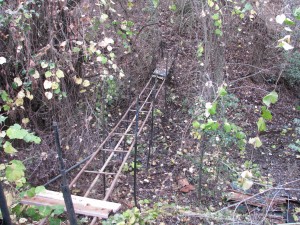
All the old stuff had to be stripped off the framework. The bridge was sprawling across the barranca when we moved here 13 years ago. Although the pipes screwed together were actually solid enough, the plywood, tar paper and carpeting that made up the walkway was well on its way to rot.

The metal frame looked bad but actually was stable. The other side of the barranca is home to poison oak, and getting to the bridge was difficult as erosion diminished the hillside. Now through permaculture, the erosion has been eliminated and thanks to Roger Boddaert and his crew there is a wonderful walkway down to the bridge. However, the bridge was unusable and had broken branches hanging over it. The barranca itself is very beautiful and a wonderful bird-watching location, so revitalizing the bridge with natural building materials would turn the eyesore into a beautiful addition to the gardens.

Jacob and Steve harvesting bamboo. Jacob Hatch and his father-in-law Steve have had the task of harvesting, splitting and working with the bamboo.That is because, as I’ve admitted freely in past posts that my building abilities rate right up there with my ability to cut hair, with about the same disasterous results. I can see what I want in my mind, but my hands aren’t paying attention.
First Jacob and Steve had to clear the bridge of the tar paper and rotted plywood and test the metal pieces for strength.
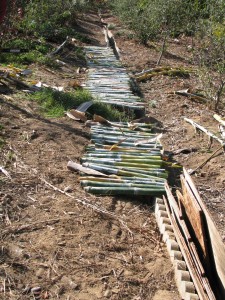
Bamboo cut to lengths. Working from a library book, they harvested the heavy water-laden shoots. After cutting the pieces to the correct width for the bridge, they used a sharpened old knife and a rubber mallet to split the stalks.
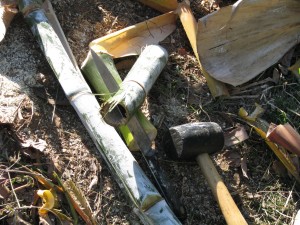
A rubber mallet and sharpened knife were all that was needed to split the bamboo. UnfortunatelyInside the sheaths there was a black fuzz that caused both of them to itch. Steve and a third helper Jake screwed the horizontal pieces onto the long supports.

Steve and Jake screw bamboo onto the frame while Sophie looks on. They built sections, then carried them down and installed them on the existing bridge poles, with the long pieces of bamboo fitting outside of and hiding the metal. Bamboo was then wired on to the uprights, and a railing was installed.

The walkway laid out. Finally the ends were tied with sisal rope. This added strength as well as beauty to the finished work.
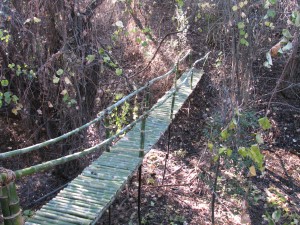
Bamboo railings in place with sisal ties and wire. The bamboo is still green; as it ages it will cure. Beads of oil will form on the top and the oil will be rubbed into the bamboo to strengthen it even more as it hardens and dries. Right now the bamboo is a little slippery to walk on, especially when damp. The bridge was built with a slight downward slope to it as well.

Strong enough for two big men: Jacob and Steve on the finished bridge! Ta-da! A really terrific and usable bridge! It certainly won’t pass OSHA safety standards, but its fine for a private home with no little kids around. The barranca looks like some exotic location, built with materials grown on site. Next projects include a small bridge, a short pier for the pond, and a ‘moon gate’ trellis for the passionvine that is out of control. Good thing I have a lot of bamboo.

